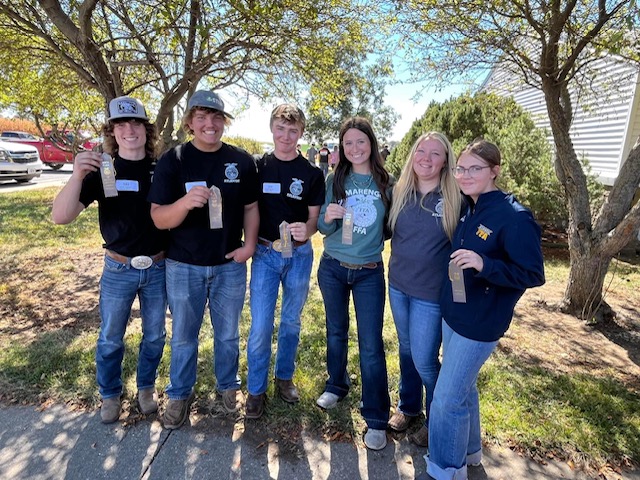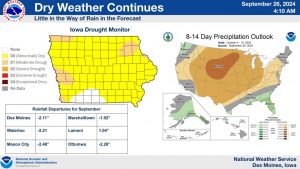CLICK HERE for the latest market quotes from the Iowa Agribusiness Network!
CLICK HERE for the latest market quotes from the Brownfield Ag News Network!
CLICK HERE for the latest market quotes from the Iowa Agribusiness Network!
CLICK HERE for the latest market quotes from the Brownfield Ag News Network!
(Radio Iowa) – Rainfall in the spring and early summer briefly relieved drought in the Corn Belt but it also contributed to elevated nitrate concentrations in many of the region’s waterways. During dry years, nitrates from soil microbes and farm fertilizers can accumulate in fields until it rains and a lot of it flushes into rivers, lakes and sources of drinking water. America’s Watershed Initiative executive director Kim Lutz works across 31 states.
Steve Kalkhoff is a hydrologist with the U-S Geological Survey, which collects a lot of this data.
Lutz says this pollution is a problem for habitats in and around affected waterways… and it’s hurting industries like fishing and tourism. It’s also costing communities a lot of money to treat drinking water. But Lutz says new federal funding and conservation practices like cover crops can help.
(Radio Iowa) – Congress has failed for a second year to pass a new Farm Bill. The one-year extension of the legislation expired yesterday (Monday) and the temporary spending package congress approved last week to keep the government operating through December 20th did not include even a temporary continuation of Farm Bill policies. Congressman Zach Nunn, a Republican who represents Iowa’s third district, had hoped the U.S. House would vote on a version of the Farm Bill that won bipartisan approval in the House Ag Committee four months ago.
Congress is now on recess through November 12th. Nunn says even if the House had taken action, the Senate Ag Committee hasn’t developed its version of the five-year Farm Bill.
Nunn acknowledges congress won’t revisit Farm Bill negotiations until after the election.
Lanon Baccam is the Democrat who’s running against Nunn in this year’s election. Congressman Randy Feenstra, the Republican who represents Iowa’s fourth district, is also a member of the House Ag Committee. Feenstra says it’s been nearly 130 days since that committee passed its version of the Farm Bill. Feenstra says given low commodity prices and declining farm income, congress needs to approve a new Farm Bill to deliver certainty and relief for Iowa agriculture. Ryan Melton, the Democrat who’s running against Feenstra, says Feenstra is serving in the least productive U.S. House in modern history and the Farm Bill is long overdue.
Today: Sunny with a high near 70. North wind 5 to 10 mph.
Tonight: Mostly clear with a low around 42.
Wednesday: Sunny with a high near 80. Breezy, with a south southwest wind 10 to 20 mph, with gusts as high as 25 mph.
Thursday: Sunny with a high near 81
Friday: Sunny with a high near 76.
Saturday: Sunny with a high near 85. Breezy.
(Radio Iowa) – Governor Kim Reynolds spent about a third of the month of September on a trade mission in India. Reynolds says the groundwork for her meetings was laid decades ago by the Iowa native who won the 1970 Nobel Peace Prize for his research that improved wheat and rice yields.
Borlaug took a wheat variety he’d developed to India in the mid-1960s and increased wheat production there by 60 percent.*
Reynolds met with India’s Secretary of Agriculture as well as the country’s Minister for Food Processing and Minister of Commerce. Iowa Corn Growers President Stu Swanson says a memorandum of agreement was signed to promote discussions between Iowa’s and India’s feed sectors.
An Iowa-based start-up company called “Power Pollen” also signed a letter of agreement with an India company called V-R-N Seed that does business in the Middle East, Africa and Southeast Asia. Power Pollen, which is based in Ames, has developed a process for collecting pollen, storing it and then applying it to fields to increase production of rice, wheat and corn seeds.
(Radio Iowa) – An analysis from the group Food & Water Watch says Iowa is the top-ranking state for producing manure from livestock feeding operations at 109 billion pounds annually. Amanda Starbuck is the nonprofit organization’s research director.
Starbuck says there is a difference between the two types of waste.
While manure can add nutrients and organic matter to farm fields, Starbuck says the sheer amount of waste is too much for the land to handle.
Food & Water Watch used the latest data from the U-S Census of Ag and the E-P-A’s definition of medium-sized concentrated animal feeding operations to develop state rankings and create interactive maps. The 20-year trends across the U-S show fewer farms but larger livestock operations.
The massive hurricane that blew into Florida and the southern U-S won’t be felt directly in Iowa, but it will have an indirect impact. Iowa D-N-R hydrologist Tim Hall says the forecast shows the weather system will keep things dry here.
Hall says the impact could keep rain away for up to seven days. The storm could have a positive impact as it brings rain to southeast Ohio.
The Mississippi River carries barges full of Iowa grain and the lower Mississippi River water levels have been down due to drought in the Ohio River valley.
Hall says we won’t get the rain, but can be glad it is going to fall somewhere that will benefit Iowa farmers.
The Iowa D-O-T keeps track of barge traffic on the Mississippi and has recently said barges would have to carry less grain with lower water levels, and that can increase grain transportation costs.
Today: Sunny with a high near 85. Light and variable wind becoming south southwest 5 to 10 mph in the morning.
Tonight: Mostly clear with a low around 48. Breezy, with a north wind 15 to 20 mph, with gusts as high as 25 mph.
Tuesday: Sunny with a high near 68. North wind at 10 mph, with gusts as high as 20 mph.
Wednesday: Sunny with a high near 78. Breezy, with a south southwest wind 10 to 20 mph, with gusts as high as 25 mph.
Thursday: Sunny with a high near 79.
Friday: Sunny with a high near 74.
(Atlantic, Iowa [Story by Atlantic FFA reporter Maddy Anderson]) – The Atlantic FFA chapter competed in the Southwest Iowa District Soils Judging Contest at the Armstrong Research Farm in Lewis, on Wednesday, September 25th. Atlantic FFA had 6 individuals compete in 2 teams. One team that place 9th, consisted of Lily Johnson, Frank Freund, and Hayden Kleen. Members of Team 2, consisting of Jarrett Hansen, Jacquie Freund and Rylie Vandevanter, placed 25th out of 47 teams.
The Soils Judging Career Development Event is designed towards motivating students to gain knowledge on surface features, the soil profile, land capability and productivity, evaluation of land use and management practices, and suitability of soils for non-agricultural uses. Students also develop the ability to observe selected soil properties, and use these observations to interpret and evaluate these properties for recommendations for land use.

Team members from left to right are: Jarett Hansen, Hayden Kleen, Frank Freund, Lily Johnson, Rylie Vandevanter, Jaquie Freund. (photo submitted)
After the contest took place, Lily Johnson said, “I enjoyed getting the opportunity to go study soil and learn about the different things that contribute to soils judging and was very pleased with how our team placed!”
(Radio Iowa) – The latest report from the U-S Drought Monitor showed a slight improvement with six percent of the state showing no dry conditions. D-N-R hydrologist Tim Hall says the majority of the state is listed as “abnormally dry,” or just before the drought level. “That’s either a precursor to or remnants of coming out of drought. So in the conditions we’re in where we’re kind of on the edge of being in drought and not being in drought,” Hall says. There are some areas in western Iowa and far northeast that have moderate drought. Hall says the dry weather can be an asset to farmers right now.
“From an ag producer perspective, being dry is great because it doesn’t cause any problems with getting into the field. You get really good grain dry down. Those are all good,” he says. Hall says it would not be good to go much longer without some rainfall. “Thinking forward to the next crop year, we need to be adding some moisture into the soil profile,” Hall says. “So it’s not good when we have a September like we’re in. This is likely to end up being the driest September ever on record for the state of Iowa.” Hall says when you look outside of agriculture needs, the state’s water systems are okay. 
“Fortunately for the state of Iowa, we had some wetter than normal months for most of the last 12 months, going back to October of last year. So coming out of some pretty decent wet months this spring and early this summer, we’re in much better shape than we would be had we not had that rain,” he says. Hall says rain naturally drops off as we head through fall and into winter, so making up the gap from the dry September may not be easy.
(Bethesda, MD) – Officials with the U.S. Consumer Product Safety Commission report John Deere is recalling multiple models of its Compact Utility Tractors over concerns that their brake systems could fail, creating risk for crashes or injury. The Illinois-based company says there have been four reported incidents — including one hospitalization, two injuries, and some minor property damage. The recalled Compact Utility Tractor models are 1023E, 1025R and 2025R. John Deere says those models can be identified by the model numbers printed on the machines’ hoods. Consumers should stop using these tractors immediately.
The affected models were sold by authorized John Deere dealers from November 2017 through July 2024, and cost between $12,700 and $21,000. The company estimates about 147,900 units are affected. Customers can also check serial numbers for recalled models at the John Deere recalls page.

(Courtesy of John Deere via U.S. Consumer Product Safety Commission)
John Deere advises customers to stop using the affected machines and to contact an authorized John Deere dealer to schedule a free repair of the front bell crank in the brake linkage. The company says it’s also reaching out to known purchasers directly.
For more information, customers can visit John Deere online or call Deere & Company from 8 a.m. to 6 p.m. ET Monday through Friday, and 9 a.m. to 3 p.m. ET Saturdays.